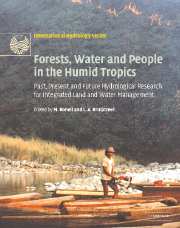 Forests, Water and People in the Humid Tropics
Forests, Water and People in the Humid Tropics from Part III - Forest disturbance, conversion and recovery
Published online by Cambridge University Press: 12 January 2010
INTRODUCTION
The rainforests of the humid tropics are being converted to alternative land uses at an increasing rate (Drigo, this volume). In many cases the initial forest disturbance preceding conversion occurs during mechanised harvesting of (large volumes of) valuable timber (Chappell, Tych et al., Cassells and Bruijnzeel, Thang and Chappell, all this volume). Timber extraction causes a number of disturbances to the soil surface, notably during the construction and subsequent use of haulage roads, tractor tracks and log landings, but also in the form of scars by falling trees, particularly in steep terrain (cf. Kamaruzaman, 1991; Dykstra and Heinrich, 1996). Soil impacts may be lessened in some cases by the manual skidding of logs on wooden rails (usually in relatively flat terrain) or through the use of high-lead or low-lead cable yarding (Figure 22.1) (Bruijnzeel, 1992; Bruenig, 1996). Uphill logging, in which log landings are located on ridge tops, is the preferred system nowadays as this has a number of advantages: (i) access roads can be built along the ridges which usually form the driest part of the landscape, thereby minimising the frequency of road closures during periods of high rainfall; (ii) the log landings are also situated on dry spots which facilitates vehicle operation; (iii) the timber extraction network fans out in a downhill direction, thereby reducing surface runoff accumulation (and thus erosion) on tractor tracks; and (iv) the number of stream crossings is minimised in this way (Dykstra and Heinrich, 1996; cf. Figure 35.4 in Cassells and Bruijnzeel, this volume).
To save this book to your Kindle, first ensure no-reply@cambridge.org is added to your Approved Personal Document E-mail List under your Personal Document Settings on the Manage Your Content and Devices page of your Amazon account. Then enter the ‘name’ part of your Kindle email address below. Find out more about saving to your Kindle.
Note you can select to save to either the @free.kindle.com or @kindle.com variations. ‘@free.kindle.com’ emails are free but can only be saved to your device when it is connected to wi-fi. ‘@kindle.com’ emails can be delivered even when you are not connected to wi-fi, but note that service fees apply.
Find out more about the Kindle Personal Document Service.
To save content items to your account, please confirm that you agree to abide by our usage policies. If this is the first time you use this feature, you will be asked to authorise Cambridge Core to connect with your account. Find out more about saving content to Dropbox.
To save content items to your account, please confirm that you agree to abide by our usage policies. If this is the first time you use this feature, you will be asked to authorise Cambridge Core to connect with your account. Find out more about saving content to Google Drive.